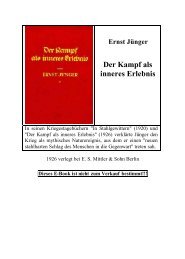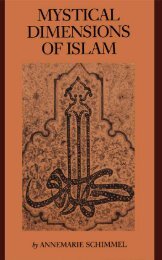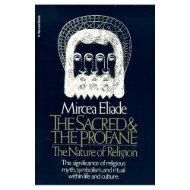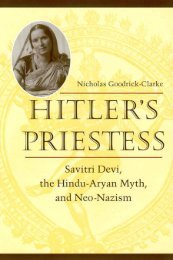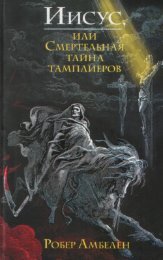- Page 2: Olga Rudge and Ezra Pound
- Page 5 and 6: Excerpt from Shakespeare and Compan
- Page 8 and 9: Contents Preface ix Acknowledgments
- Page 10 and 11: Preface That her acts Olga’s acts
- Page 12 and 13: Acknowledgments Poet Desmond O’Gr
- Page 14 and 15: xiii Acknowledgments Northern Irela
- Page 16 and 17: xv Acknowledgments the most useful
- Page 18 and 19: 1 Olga and Ezra in Paris 1922-1923
- Page 20 and 21: 3 Olga and Ezra in Paris dante, and
- Page 22 and 23: 5 Olga and Ezra in Paris generation
- Page 24 and 25: 7 Olga and Ezra in Paris Olga, dete
- Page 26 and 27: 9 Olga and Ezra in Paris with an ap
- Page 28 and 29: 11 Julia and Her Daughter late gett
- Page 30 and 31: 13 Julia and Her Daughter 733 Bryso
- Page 32 and 33: 15 Julia and Her Daughter the pride
- Page 34 and 35: 17 Julia and Her Daughter placed in
- Page 36 and 37: 19 Julia and Her Daughter To anyone
- Page 38 and 39: 21 Julia and Her Daughter have big
- Page 40 and 41: 23 Julia and Her Daughter and her d
- Page 44 and 45: 27 Halcyon Days No More Marcel Prou
- Page 46 and 47: 29 Halcyon Days No More While in Fl
- Page 48 and 49: 31 Halcyon Days No More Gilbert was
- Page 50 and 51: 33 Halcyon Days No More dread of al
- Page 52 and 53: 35 Halcyon Days No More Olga was bo
- Page 54 and 55: 37 Halcyon Days No More May 15, he
- Page 56 and 57: 39 Halcyon Days No More 1934, when
- Page 58 and 59: 4 Lost Loves 1918-1922 ‘‘We mak
- Page 60 and 61: 43 Lost Loves maladie,’’ in the
- Page 62 and 63: 45 Lost Loves wrote of Cleo Gazay i
- Page 64 and 65: 47 Lost Loves but do nothing to the
- Page 66 and 67: 49 Lost Loves the record straight,
- Page 68 and 69: 51 A Marriage That Didn’t Happen
- Page 70 and 71: 53 A Marriage That Didn’t Happen
- Page 72 and 73: 55 A Marriage That Didn’t Happen
- Page 74 and 75: 57 A Marriage That Didn’t Happen
- Page 76 and 77: 59 A Marriage That Didn’t Happen
- Page 78 and 79: 61 A Marriage That Didn’t Happen
- Page 80 and 81: 63 A Marriage That Didn’t Happen
- Page 82 and 83: 65 A Marriage That Didn’t Happen
- Page 84 and 85: 67 A Marriage That Didn’t Happen
- Page 86 and 87: 69 A Marriage That Didn’t Happen
- Page 88 and 89: 71 The Hidden Nest In spite of Ezra
- Page 90 and 91: 73 The Hidden Nest [The] photograph
- Page 92 and 93:
75 The Hidden Nest in 1927 to rekin
- Page 94 and 95:
77 The Hidden Nest ques allait de l
- Page 96 and 97:
79 The Hidden Nest take a passage f
- Page 98 and 99:
81 The Hidden Nest through, but ins
- Page 100 and 101:
83 The Hidden Nest American expatri
- Page 102 and 103:
85 The Hidden Nest No, you God Dam
- Page 104 and 105:
87 The Breaking Point where people
- Page 106 and 107:
89 The Breaking Point working with
- Page 108 and 109:
91 The Breaking Point enough income
- Page 110 and 111:
93 The Breaking Point And all this
- Page 112 and 113:
95 The Breaking Point Café Yolanda
- Page 114 and 115:
97 The Breaking Point cided about t
- Page 116 and 117:
99 The Breaking Point from Japan, a
- Page 118 and 119:
101 The Breaking Point On October 3
- Page 120 and 121:
8 Rare and Unforgettable Little Con
- Page 122 and 123:
105 Rare and Unforgettable Concerts
- Page 124 and 125:
107 Rare and Unforgettable Concerts
- Page 126 and 127:
109 Rare and Unforgettable Concerts
- Page 128 and 129:
111 Rare and Unforgettable Concerts
- Page 130 and 131:
113 Rare and Unforgettable Concerts
- Page 132 and 133:
115 Rare and Unforgettable Concerts
- Page 134 and 135:
117 Rare and Unforgettable Concerts
- Page 136 and 137:
119 Rare and Unforgettable Concerts
- Page 138 and 139:
121 Rare and Unforgettable Concerts
- Page 140 and 141:
123 Rare and Unforgettable Concerts
- Page 142 and 143:
125 Rare and Unforgettable Concerts
- Page 144 and 145:
127 The Red Priest of Venice of [th
- Page 146 and 147:
129 The Red Priest of Venice who wa
- Page 148 and 149:
131 The Red Priest of Venice about
- Page 150 and 151:
133 The Red Priest of Venice going
- Page 152 and 153:
10 Overture to War 1939-1940 ‘‘
- Page 154 and 155:
137 Overture to War ’normous bunc
- Page 156 and 157:
139 Overture to War concertos, mote
- Page 158 and 159:
The sword, carnage, vengeance, rage
- Page 160 and 161:
11 The Subject Is—Wartime 1941-19
- Page 162 and 163:
145 The Subject Is—Wartime brogio
- Page 164 and 165:
147 The Subject Is—Wartime trying
- Page 166 and 167:
149 The Subject Is—Wartime Olga
- Page 168 and 169:
151 The Subject Is—Wartime second
- Page 170 and 171:
153 The Subject Is—Wartime The Co
- Page 172 and 173:
155 The Subject Is—Wartime Britis
- Page 174 and 175:
12 The Road to Hell 1945 ‘‘Four
- Page 176 and 177:
159 The Road to Hell these were rou
- Page 178 and 179:
161 The Road to Hell seven. More K-
- Page 180 and 181:
163 The Road to Hell Rome oggi. Nat
- Page 182 and 183:
165 The Road to Hell Their correspo
- Page 184 and 185:
167 The Road to Hell chance.’’
- Page 186 and 187:
169 The Road to Hell thank her for
- Page 188 and 189:
171 What Thou Lovest Well Remains m
- Page 190 and 191:
173 What Thou Lovest Well Remains c
- Page 192 and 193:
175 What Thou Lovest Well Remains a
- Page 194 and 195:
177 What Thou Lovest Well Remains a
- Page 196 and 197:
179 What Thou Lovest Well Remains C
- Page 198 and 199:
181 What Thou Lovest Well Remains w
- Page 200 and 201:
183 What Thou Lovest Well Remains c
- Page 202 and 203:
185 What Thou Lovest Well Remains S
- Page 204 and 205:
187 What Thou Lovest Well Remains h
- Page 206 and 207:
189 What Thou Lovest Well Remains t
- Page 208 and 209:
191 What Thou Lovest Well Remains m
- Page 210 and 211:
193 A Visitor to St. Elizabeth’s
- Page 212 and 213:
195 A Visitor to St. Elizabeth’s
- Page 214 and 215:
197 A Visitor to St. Elizabeth’s
- Page 216 and 217:
199 A Visitor to St. Elizabeth’s
- Page 218 and 219:
201 A Visitor to St. Elizabeth’s
- Page 220 and 221:
203 A Visitor to St. Elizabeth’s
- Page 222 and 223:
205 A Visitor to St. Elizabeth’s
- Page 224 and 225:
207 A Visitor to St. Elizabeth’s
- Page 226 and 227:
209 A Visitor to St. Elizabeth’s
- Page 228 and 229:
211 A Visitor to St. Elizabeth’s
- Page 230 and 231:
15 A Piece of Ginger 1956-1962 ‘
- Page 232 and 233:
215 A Piece of Ginger Public opinio
- Page 234 and 235:
217 A Piece of Ginger spying on her
- Page 236 and 237:
219 A Piece of Ginger dell’errore
- Page 238 and 239:
221 A Piece of Ginger ‘‘Is it p
- Page 240 and 241:
223 A Piece of Ginger tainment for
- Page 242 and 243:
225 A Piece of Ginger waiting all h
- Page 244 and 245:
16 The Last Ten Years 1962-1972 ‘
- Page 246 and 247:
229 The Last Ten Years ‘‘takes
- Page 248 and 249:
231 The Last Ten Years given me war
- Page 250 and 251:
233 The Last Ten Years gives a behi
- Page 252 and 253:
235 The Last Ten Years gathering pl
- Page 254 and 255:
237 The Last Ten Years Cornelio Faz
- Page 256 and 257:
239 The Last Ten Years nolly, whom
- Page 258 and 259:
241 The Last Ten Years have said
- Page 260 and 261:
243 The Last Ten Years As a hostess
- Page 262 and 263:
245 The Last Ten Years The next mor
- Page 264 and 265:
247 The Last Ten Years and Italians
- Page 266 and 267:
249 The Last Ten Years in the amoun
- Page 268 and 269:
251 The Last Ten Years Mario Casama
- Page 270 and 271:
253 The Last Ten Years the mayor of
- Page 272 and 273:
255 The Last Ten Years stone paths.
- Page 274 and 275:
257 The Last Ten Years hospital, S.
- Page 276 and 277:
259 Olga Triumphant Senator Vittori
- Page 278 and 279:
That lurks behind the hills, shall
- Page 280 and 281:
263 Olga Triumphant On December 5 s
- Page 282 and 283:
265 Olga Triumphant that we may put
- Page 284 and 285:
267 Olga Triumphant influenced, inc
- Page 286 and 287:
269 Olga Triumphant War I flying ac
- Page 288 and 289:
271 Olga Triumphant In her later ye
- Page 290 and 291:
273 Olga Triumphant had been the co
- Page 292 and 293:
275 Olga Triumphant The social life
- Page 294 and 295:
277 Olga Triumphant monde qui gouve
- Page 296 and 297:
279 Olga Triumphant the Italian con
- Page 298 and 299:
281 Olga Triumphant Olga to San Mic
- Page 300 and 301:
283 Olga Triumphant Christmas Day w
- Page 302 and 303:
285 Olga Triumphant Rylandses as an
- Page 304 and 305:
287 Olga Triumphant tite for food a
- Page 306 and 307:
289 Coda window: ‘‘Mother alway
- Page 308 and 309:
Notes The primary sources of this b
- Page 310 and 311:
1olga and ezra in paris (1922-1923)
- Page 312 and 313:
295 Notes to Pages 14-23 p. 14 ‘
- Page 314 and 315:
297 Notes to Pages 32-42 p. 32 ‘
- Page 316 and 317:
299 Notes to Pages 51-58 p. 51 ‘
- Page 318 and 319:
301 Notes to Pages 66-71 p. 66 ‘
- Page 320 and 321:
303 Notes to Pages 80-88 p. 80 ‘
- Page 322 and 323:
305 Notes to Pages 96-106 p. 96 ‘
- Page 324 and 325:
307 Notes to Pages 113-120 p. 113
- Page 326 and 327:
309 Notes to Pages 127-133 p. 127
- Page 328 and 329:
311 Notes to Pages 138-142 p. 138
- Page 330 and 331:
313 Notes to Pages 150-156 p. 150
- Page 332 and 333:
315 Notes to Pages 168-176 p. 168
- Page 334 and 335:
317 Notes to Pages 183-190 p. 183 B
- Page 336 and 337:
319 Notes to Pages 199-208 p. 199 D
- Page 338 and 339:
321 Notes to Pages 217-224 p. 217 p
- Page 340 and 341:
323 Notes to Pages 232-243 p. 232 T
- Page 342 and 343:
325 Notes to Pages 254-266 p. 254 A
- Page 344:
327 Notes to Pages 284-290 p. 284 T
- Page 347 and 348:
330 Secondary Sources Bornstein, Ge
- Page 349 and 350:
332 Secondary Sources Mackenzie, Co
- Page 351 and 352:
334 Secondary Sources Vannini, Arma
- Page 353 and 354:
336 Index Auden, W. H., 134, 215 Au
- Page 355 and 356:
338 Index Clark, Lady Frances, 265,
- Page 357 and 358:
340 Index Gautier, Théophile, 2, 2
- Page 359 and 360:
342 Index La Quiete. See Montalve,
- Page 361 and 362:
344 Index Nixon, David, 130 Noaille
- Page 363 and 364:
346 Index Pound, Isabel (mother), 4
- Page 365 and 366:
348 Index —relations with: (conti
- Page 367 and 368:
350 Index Umberto, Crown Prince of



